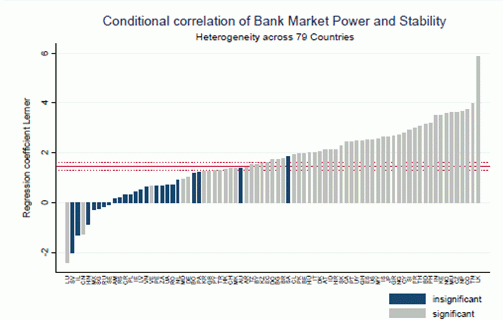The impact of bank competition on financial stability remains a widely debated and controversial issue, both among policymakers and academics (see for example Vives 2010 and Goodhart and Persaud 2011 on this site).
The belief that fiercer competition among banks would lead to a more effective banking system initiated a deregulating spiral in the late 70s and early 80s.
While this may have resulted in more intense competition among banks, with positive repercussions for financial depth and efficiency, it may as well have had the unintended consequence of increasing banking-sector instability (see among others Keeley 1990).
The international process of banking liberalisation has seemingly gone hand in hand with an increased occurrence of systemic banking crises in the last two decades of the twentieth century, culminating in the global financial crisis of 2007-2009.
However, there is no academic consensus on whether bank competition leads to more or less stability in the banking system.
What does theory and previous empirical work tell us?
In recent research (Beck et al. 2011), we explore cross-country heterogeneity in the competition-stability relationship in banking. Specifically, we examine whether cross-country variation in market structure, the regulatory framework and the institutional environment in which banks operate explains cross-country heterogeneity in the competition-stability relationship.
The theoretical literature has offered contrasting hypotheses on the impact of competition on stability. On the one hand, the "charter value" view of banking sees banks as choosing the risk of their asset portfolio. In a more competitive environment with more pressure on profits, banks have higher incentives to take more excessive risks, resulting in higher fragility. On the other hand, Boyd and De Nicoló (2005) show that lower lending rates reduce the entrepreneurs' cost of borrowing and increase the success rate of entrepreneurs' investments. In addition, these firms will refrain from excessive risk-taking to protect their increased franchise value. As a consequence, banks will face lower credit risk on their loan portfolio in more competitive markets, which should lead to increased banking-sector stability. Empirical studies for specific countries – many if not most for the US – have not come to conclusive evidence for either a stability-enhancing or a stability-undermining role of competition. The cross-country literature has found that more concentrated banking systems are less likely to suffer a systemic banking crisis as are more competitive banking systems (Beck et al. 2006).
While there is a direct impact of the market, regulatory and institutional structures on banks’ fragility, there might be an important interaction between these country characteristics and the impact of competition on stability. Specifically, we argue that country-specific features may affect the existing empirical evidence on the relationship between competition and stability via three possible channels.
- First, a certain type of regulation may limit the extent to which banks can or will engage in riskier activities if their franchise values are eroded.
For example, regulatory capital requirements should limit the extent to which banks can follow risk-taking incentives if banks' charter value is eroded. This would thus influence the strength of the competition-fragility relationship.
- Second, country-specific characteristics may also affect the adverse selection problem that banks face if they charge higher loan rates.
For example, credit registries, which facilitate information sharing across banks, may reduce the likelihood that entrepreneurs will chose riskier project in response to higher loan rates. This would thus influence the strength of the competition-stability relationship.
- Third, institutional characteristics may affect the proportion of systematic and idiosyncratic risk in loan defaults and may make it hence more likely that the empirical data favour one theory over the other.
For example, regulatory constraints on diversification may make it more likely that loan defaults are highly correlated and hence lead to the empirical outcome that competition is good for financial stability. The relative strength of each of these three channels may explain why different studies obtain different results in terms of magnitude or even sign.
Finding the data
We combine data from several sources. We obtain information on banks' balance sheets and income statements from Bankscope for the period 1994 to 2009, thus including the recent crisis. All results, however, are robust to dropping the last three years of our sample. We combine these bank-level data with data from the three waves (1997, 2001 and 2005) of the Bank Regulation and Supervision database compiled by the World Bank (Barth et al. 2008), as well as data from the Doing Business database.
As our ultimate goal is documenting and explaining the variability in the competition-stability relationship across countries, we need a measure of market power that varies at the bank level rather than a competition or concentration proxy at the country level. The Lerner index, defined as the mark-up over marginal costs, is the only measurable market-power indicator that varies at the bank level. Similarly, we need a bank-level measure of fragility and use the Z-score, defined as return on assets plus equity-asset ratio, divided by the standard deviation of return on assets. While in large parts of the literature the volatility of profits is computed over the full sample period, we use a three-year rolling time window for the standard deviation of return on assets to allow for time variation in the denominator of the Z-score. This approach helps avoid the fact that the variation in Z-scores within banks over time is exclusively driven by variation in the levels of capital and profitability.
Cross-country variation
While we show, on average, a positive relationship between market power, as measured by the Lerner index, and stability, as measured by the Z-score, we find large cross-country variation in this relationship. Figure 1 shows the coefficient on the Lerner index in a regression of the Z-score controlling for year fixed effects and bank-specific characteristics and illustrates this cross-country heterogeneity. Coefficients vary from negative and significant to almost six. The standard deviation of the coefficients across the 79 countries is 1.42. A quick look at the country labels on the X-axis also reveals that it is not just a developed versus developing countries story or that regions exhibit similar behaviour.
Figure 1. Conditional correlation of bank market power and stability
When relating this variation in the conditional relationship between banks’ market power and stability across countries and over time to regulatory and institutional features, we find several significant results:
- The negative impact of market power on bank fragility, as proclaimed by the risk-shifting hypothesis is more muted in countries with more effective systems of credit information sharing and better developed capital markets. This suggests that the effect of higher interest rates on borrowers’ risk taking is less negative in countries with more effective systems of credit information sharing and better developed capital markets.
- In countries with more generous deposit insurance schemes, the impact of competition on fragility is exacerbated. More generous deposit insurance schemes thus increase risk-taking incentives in more competitive environments. We find evidence that more stringent capital requirements do not contribute to a dampening of the competition-fragility relationship. We also find that distressed banks are more likely to take aggressive risk in more competitive environments.
- The impact of competition on fragility is stronger in countries with stronger activity restrictions and more homogenous banking systems. As competition increases, a stronger tendency towards herding will exacerbate fragility in such countries.
Conclusions and policy implications
To illustrate the policy relevance of our findings, consider the following. In the midst of the crisis, many countries increased the generosity of the deposit insurance schemes. At the same time, there were calls for restrictions on banks' activities, as previously under the Glass-Steagall Act in the US. Mimicking this post-crisis scenario reveals that the relationship between market power and soundness in this fictitious ceteris paribus analysis is almost twice as strong compared to the benchmark case, suggesting a very negative impact of competition on stability in this scenario. In the base scenario, a one standard deviation reduction in market power leads to a drop in the Z-score of 20%. In our fictitious post-crisis scenario with more generous deposit insurance, increased activity restrictions on banks and more revenue herding, a similar loss in market power leads to a 38% reduction in the average Z-score, i.e. the buffer of capital against losses expressed in terms of profit volatility.
References
Acharya, V and T Yorulmazer (2007), “Too many to fail. An analysis of time-inconsistency in bank closure policies”, Journal of Financial Intermediation, 16(1), 1-31.
Barth, J, G Caprio, and R Levine (2006), Rethinking Bank Supervision and Regulation: Until Angels Govern, Cambridge University Press.
Barth, J, G Caprio, and R Levine (2008), Bank Regulation and Supervision Database (updated June 2008), World Bank.
Beck, T, A Demirguc-Kunt, and R Levine (2006), “Bank concentration, competition, and crises: First results”, Journal of Banking and Finance, 30(5),1581-1603.
Beck, T, O de Jonghe, and G Schepens (2011), “Bank competition and stability: cross-country heterogeneity”, Centre Discussion Paper
Boyd, JH, and G De Nicolo (2005), “The Theory of Bank Risk Taking and Competition Revisited”, Journal of Finance, 60(3):1329-1343.
Brown, CO, and SI Dinc (2011), “Too Many to Fail? Evidence of Regulatory Forbearance When the Banking Sector Is Weak”, Review of Financial Studies, 24(4):1378-1405.
Demirguc-Kunt, A, and E Kane (2002), “Deposit Insurance around the Globe: Where Does It Work?”, Journal of Economic Perspectives, 16(2):175-195.
Goodhart, CAE and A Persaud (2011), “Not far enough: Recommendations of the UK's Independent Commission on Banking”, VoxEU.org, 13 May.
Keeley, MC (1990), “Deposit Insurance, Risk, and Market Power in Banking”, American Economic Review, 80(5):1183-1200.
Vives, Xavier (2010), “Competition and stability in banking”, VoxEU.org, 18 September.






